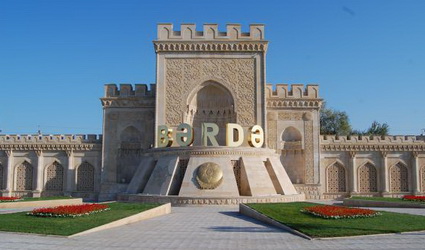 Barda– region in Azerbaijan.
Barda– region in Azerbaijan.
Barda region was granted an administrative area status in 1930. Barda has one town and 110 villages.
73 institutions, 32 pre-school children institutions, 76 schools, 16 medical institutions, 205 cultural institutions exist in the region.
History
Barda region was created on 8 August 1930. It is situated in north-west part of Kur-Araz Lowland.
Barda city, the centre of the region is the oldest settlement of not only Azerbaijan, but Near East in general. This fact is proved by materials revealed during archaeological excavations, including coins belonged to the time of Alexander of Macedonia, Arakyds and Roman emperor August. The obtained sources indicate Barda’s collaboration with countries existed B.C.
Arabian historian Belazuri (9th century) notified that Barda was established during the time of Sasanyds sovereign I Gubad (483-531), Iranian historian Hamdullah Gazvini (14th century) informed that it was established during the time of Alexander of Macedonia (B.C. 336-323). According to the information given by Moses Kalankatli Barda was established during the time of II Vache by instructions of Firuz (459-484). During that time name of Barda was ‘Firuzabad’. “Kitabi-Dada Gorgud” epos deals with Barda, too.
Barda was the center of Governorship during Sasanyds. Barda was surrounded with walls during the time of I Gubad. It was the capital of Albania in 10th century and center of Albanian Church was removed to Barda in 552. Barda was invaded by Caspian tribes in 628, by Iranian feudal lords in 639. Albanian sovereign Javanshir could banish them from Barda. During the time of Caliph Osman (644-656) Arabian troops occupied Barda. 100 thousand population lived in Barda during 6-7th centuries. Coins were minted in Barda during 13th century. Barda was the center of Arran province in 752. Barda became a significant trade and cultural center during 8-9th centuries. Popular “Al-Kurkiy” market was located nearness of Barda gate. Barda was in the structure of Sasanyds state. Barda also was one of the important strength sources of Khurramyds movement.
The city has been called as “Head city of Arran”, Mother of Arran” in some historical sources.
Barda known as mastership and trade center in Near and Middle East was attacked by the Russian in 944. Barda citizens were punished mercilessly by the Russian as they did not leave their home town for one day. 20 thousands of Barda citizens were put to the sword by the Russian. Plague was spread in the territory, therefore the Russian were compelled to leave Barda. Barda could not come to itself for a long time after pillages of the Russian. Fazl (985-1030) from dynasty of Shaddadis included Barda to his state in 993. Barda was under subordination of Seljugs in 11th, and Eldagizeds in 12th century. Barda was collapsed by attacks of Mongols again, restored during the period of Elkhanyds. Barda was destroyed again during the attack of Amir Teymur. Barda has been in structure of the Karabakh khanate during the khanates time. Armenians were removed to Karabakh, as well as Barda by the Russian after occupation of Karabakh khanate in 1804. Only more than 1000 Armenian families were moved to Barda in 1828 (4). During occupation by Russia, Barda was in the structure of Elzabethpol province, but was in the structure of Azerbaijan after that gained its independence in 1918.
Geography
Barda city is in the central part of country-400.25 is in the north wide and 470.05 is in the east longitude, is situated in Kur-Araz Plain, at height of 87 metres from sea level, in the center of Garabagh lowland.
Region having the same border with Tartar region from west, Yevlakh city from north, Aghdash region from north-east and east and Zardab region from south-east along the Kur River, Aghdam and Aghjabadi regions from south.
The region is connected with other regions by motor road and with capital of republic, Yevlakh city, Aghdash, Ujar and Kurdamir regions by railway.
There operate 35 administrative territorial units and districts, 67 municipalities in the region.
Surface of region is less inclined and wavy plain, is covered by deposits of anthropogenic system. There are clay, gravel and sand beds, and natural spring having medicinal importance in the nearness of Mughanli Village.
Climate is mild hot, dry subtropical. Winter passes dry, average temperature is 1,2-1,8 C in January and 25,6-26,5 C in July. Annual rainfall is 250-350 mm. Mainly gray and gray-grass soils spread. Natural plant cover is typically dry field and semidesert. Sparse Riparian woods (7, 3 thousand ha) are along the bank of Kur River.
There are two lakes close each other in the right side of Barda-Tartar highway, at 3 km distance from the center of region. Lake called Aghali is at 23 km distance from Barda. Istisu- sulphurous hot water spring is situated at 3 km distance from Barda near Barda-Tartar highway. Climate is mild hot, dry subtropical.
Tartar and Khachin rivers run in the territory of region, Kur river flows along the north-east border of the region. Mainly gray and gray-grass soils spread. Natural plant cover is typically dry field and semidesert. Sparse Riparian woods (7, 3 thousand ha) are along the bank of Kur River. Protected forest is in the territory of region.
Nature
Climate is mild hot and dry subtropical. Winter is dry. Average temperature is in January 1, 2-1, 8°C, in July 25, 6-26, 5°C. Annual rainfall is 250-350 mm. Tartar and Khachin Rivers flow through the region, while Kur River along north-east border. Mainly gray and gray-grass soils are spread. Natural plant cover, basically is of dry field and semidesert type. There are sparse Tugai forests (total capacity 7, 3 thousand ha) on the bank of Kur River. Animals are fox, wolf, pig, rabbit, etc. Birds are partridge, pheasant, goose, duck and others. There is Barda Reserve in the region.
